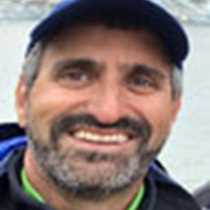Las Animas, Isla San Jose and Isla San Francisco
Our week long whale voyage hit the ocean running with sperm whales at sunrise on this our first morning. Bushy low-angled blows gave away a group of a dozen or so of these squid-seeking behemoths. With the whale silhouette of Las Animas isle in the background, members of a nursery of females and young recharged their oxygen supply before sounding with goodbye waves of the flukes. One young whale moved quickly and curiously across the surface, a lopsided breath erupting from its rising square head, followed by an undulating mid-body arch each time it surfaced. One calf swimming about its floating mother was spotted with killer whale teeth marks on its dorsal fin!
A half thousand-strong pod of common dolphins boiled the water and traveled with us for a while before commencing an impressive water-frothing sprint in a long line abreast. We enjoyed their high leaps and bow rides, and noticed tiny calves and stalked barnacles and remoras on their beautifully patterned bodies.
In the clear waters of San Jose Channel, a contingent of bottlenose dolphins took over our pressure wave gliding before the ship. One dolphin rolled sideways in the glinting water pondering the faces looking down at it. We marveled in this temporary meeting of parallel mammalian worlds through looking glass waters.
A lone humpback whale made the first baleen whale appearance of the trip. Its place in productive waters and consistent diving pattern suggested that it might be feeding, a behavior not often observed in this species during winter. A second humpback was observed smacking its impressive flukes against the surface as we positioned in to anchorage at Isla San Francisco.
Upon landing for kayaking, hiking and snorkeling activities, we discovered a tidal band of perished pelagic red crabs running the length of the crescentic beach. Swarms of these squat open water-dwelling crustaceans feed oceanic game fish, and even blue whales and endemic fish-eating bats, in addition to inspiring the Sea of Cortez’s alias as the Vermillion Sea.
Biodiversity of life was startlingly reinforced in our minds by the phantasmagoria of organisms we discovered in the tide pools at Isla San Francisco. Here where Steinbeck and Ricketts collected, we pondered nudibranchs, pistol shrimp, flatworms, brittlestars, crabs, moray eels, and other denizens of the intertidal. It is amazing the abundance and colourful diversity of life to be found in a pile of wet rocks!
Today is the vernal equinox, the sun running directly over our planet’s equator. Here in the warming desert seas of Baja California, we pondered life histories we could glean of the diverse and beautiful lifeforms we were privileged to encounter today.
Our week long whale voyage hit the ocean running with sperm whales at sunrise on this our first morning. Bushy low-angled blows gave away a group of a dozen or so of these squid-seeking behemoths. With the whale silhouette of Las Animas isle in the background, members of a nursery of females and young recharged their oxygen supply before sounding with goodbye waves of the flukes. One young whale moved quickly and curiously across the surface, a lopsided breath erupting from its rising square head, followed by an undulating mid-body arch each time it surfaced. One calf swimming about its floating mother was spotted with killer whale teeth marks on its dorsal fin!
A half thousand-strong pod of common dolphins boiled the water and traveled with us for a while before commencing an impressive water-frothing sprint in a long line abreast. We enjoyed their high leaps and bow rides, and noticed tiny calves and stalked barnacles and remoras on their beautifully patterned bodies.
In the clear waters of San Jose Channel, a contingent of bottlenose dolphins took over our pressure wave gliding before the ship. One dolphin rolled sideways in the glinting water pondering the faces looking down at it. We marveled in this temporary meeting of parallel mammalian worlds through looking glass waters.
A lone humpback whale made the first baleen whale appearance of the trip. Its place in productive waters and consistent diving pattern suggested that it might be feeding, a behavior not often observed in this species during winter. A second humpback was observed smacking its impressive flukes against the surface as we positioned in to anchorage at Isla San Francisco.
Upon landing for kayaking, hiking and snorkeling activities, we discovered a tidal band of perished pelagic red crabs running the length of the crescentic beach. Swarms of these squat open water-dwelling crustaceans feed oceanic game fish, and even blue whales and endemic fish-eating bats, in addition to inspiring the Sea of Cortez’s alias as the Vermillion Sea.
Biodiversity of life was startlingly reinforced in our minds by the phantasmagoria of organisms we discovered in the tide pools at Isla San Francisco. Here where Steinbeck and Ricketts collected, we pondered nudibranchs, pistol shrimp, flatworms, brittlestars, crabs, moray eels, and other denizens of the intertidal. It is amazing the abundance and colourful diversity of life to be found in a pile of wet rocks!
Today is the vernal equinox, the sun running directly over our planet’s equator. Here in the warming desert seas of Baja California, we pondered life histories we could glean of the diverse and beautiful lifeforms we were privileged to encounter today.




